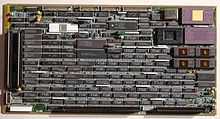3B series computers
.jpg)
The 3B series computers were a line of micro-programmable minicomputers produced by AT&T Computer Systems's Western Electric subsidiary.
High-availability processors
The original series of 3B computers include the models 3B20C, 3B20D, 3B21D, and 3B21E.
The 3B (3B20D/3B20C/3B21D/3B21E) is a 32-bit microprogrammed duplex (redundant) high availability processor unit with a real-time operating system. It is used in the telecommunications environment and was first produced in the late 1970s at the WECo factory in Lisle, Illinois. It uses the Duplex Multi Environment Real Time (DMERT) operating system which was renamed UNIX-RTR (Real Time Reliable) in 1982. The Data Manipulation Unit (DMU) provided arithmetic and logic operations on 32 bit words using AMD 2901 bipolar 4-bit processor elements.[1] The first 3B20D was called the Model 1. Each processor's control unit consisted of 2 frames of circuit packs. The whole duplex system required many seven foot frames of circuit packs plus at least one tape drive frame (most telephone companies wrote billing data on magnetic tapes), and many washing machine sized (and look with the open top door) disk drives. For training and lab purposes a 3B20D could be divided into two "half-duplex" systems. A 3B20S consisted of most of the same hardware as a half-duplex but used a completely different operating system.
The 3B20C was briefly available as a high-availability fault tolerant multiprocessing general purpose computer in the commercial market in 1984. The 3B20E was created to provide a cost reduced 3B20D for small offices that did not expect such high availability. It consisted of a virtual "emulated" 3B20D environment running on a stand-alone general purpose computer (the system was ported to many computers but primarily runs on the Sun Microsystems Solaris (operating system) environment).
There have been many improvements made to the 3B20D UNIX-RTR system in both software and hardware throughout the 1980s, 1990s, and 2000s. These included some remarkable features such as disk independent operation (DIOP: the ability to continue essential software processing such as telecommunications after duplex failure of redundant essential disks) and Off-line Boot (the ability to split in half, boot up the previously out-of-service half, verify successful boot), and Switch Forward (switch processing to the previously out-of-service half).The processor was re-engineered and renamed in 1992 as the 3B21D. It is still in use as of 2010 as a component of many Alcatel-Lucent products such as the 4ESS and 5ESS.
General-purpose computers

The general purpose family of 3B computer systems includes the 3B2, 3B5, 3B15, 3B20S, and 3B4000.
These computers were named after the successful 3B20D. The 3B20S (simplex) ran using the UNIX operating system and was developed at Bell Labs and produced by WECo in 1982 for the general purpose internal Bell System use, and later the mini-computer market. The other 3B computers were also created for this market and eventually were running UNIX System V from AT&T.
3B20S
The 3B20S was built using virtually the same hardware as the 3B20D. The machine was approximately the size of a refrigerator.
3B2


The 3B2 was introduced using the WE-32000 32-bit microprocessor with memory management chips that supported demand-paging. The 3B2 Model 300 was approximately 4 inches (100 mm) high and the 3B2 Model 400 was approximately 8 inches (200 mm) high. The 300 was soon supplanted by the 3B2/310, which featured the WE-32100 CPU as did all follow on models. The Model 400 allowed more peripheral slots and more memory. It also had a built-in 23 megabyte QIC tape drive managed by a floppy disk controller (nicknamed the "floppy tape"). These three models used standard MFM 5¼" hard disk drives. The 3B2/600 offered an improvement in performance and capacity. It featured a SCSI controller for the 60 megabyte QIC tape and two internal full-height disk drives. The 600 was approximately twice as tall as a 400, and was oriented with the tape and floppy disk drives opposite the backplane (instead of at a right angle to it as on the 3xx, 4xx and later 500 models). Early models used an internal Emulex card to interface the SCSI controller with ESDI disks, with later models using SCSI drives directly. The 3B2/500 was the next model to appear, essentially a 3B2/600 with enough components removed to fit into a 400 case. One internal disk drive and several backplane slots were sacrificed in this conversion. Unlike the 600 which, because of its two large fans was quite loud, the 500 was tolerable in an office environment, like the 400. The 3B2/700 was an uprated version of the 600 featuring a slightly faster processor. The 3B2/1000 was an additional step in this direction.
3B5
The 3B5 was built using the older Western Electric WE-32000 32-bit microprocessor. The initial versions had discrete memory management unit hardware built using gate arrays and supported segment-based memory translation. IO was programmed using memory-mapped techniques. The machine was approximately the size of a dishwasher, though adding the reel-to-reel tape drive increased it to the size of a refrigerator.
These computers used SMD hard drives.
3B15
The 3B15 was the faster followon to the 3B5, but with similar large form factor.
3B1 desktop workstation
The 3B1, also known as the PC7300 or UNIX PC, was a desktop workstation computer based on the Motorola MC68010 microprocessor, running an operating system from Convergent Technology (based on Unix System V Release 2).
In spite of the labeling and common AT&T heritage, the 3B1 was essentially unrelated in hardware or software to the 3B2 line.
See also
- AT&T Computer Systems
- Altos Computer Systems
- 4ESS switch
- 5ESS switch switching system
- WE32100 microcomputer
- DMERT operating system
References
- ↑ J. O. Becker, The 3B20D PROCESSOR and DMERT Operating System (The Bell System Technical Journal, January 1983, Vol. 62, No. 1, Part 1), Page 193
External links
| ||||||||||